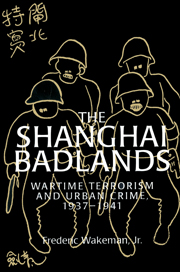Book contents
- Frontmatter
- Contents
- Dedication
- Acknowledgments
- Glossary
- Shanghai, 1940
- Metropolitan Shanghai
- Dedication
- Prologue: Consequences
- 1 Island Shanghai
- 2 Blue Shirts
- 3 National salvation
- 4 Retaliation: Pro-Japanese terrorism
- 5 Provocation: The Chen Lu assassination
- 6 Capitulation: The Xi Shitai assassination
- 7 The puppet police and 76 Jessfield Road
- 8 Terrorism and crime
- 9 Rackets
- 10 Terrorist wars
- 11 Dimout
- Epilogue: Outcomes
- Abbreviations
- Notes
- Bibliography
- Index
5 - Provocation: The Chen Lu assassination
Published online by Cambridge University Press: 02 November 2009
- Frontmatter
- Contents
- Dedication
- Acknowledgments
- Glossary
- Shanghai, 1940
- Metropolitan Shanghai
- Dedication
- Prologue: Consequences
- 1 Island Shanghai
- 2 Blue Shirts
- 3 National salvation
- 4 Retaliation: Pro-Japanese terrorism
- 5 Provocation: The Chen Lu assassination
- 6 Capitulation: The Xi Shitai assassination
- 7 The puppet police and 76 Jessfield Road
- 8 Terrorism and crime
- 9 Rackets
- 10 Terrorist wars
- 11 Dimout
- Epilogue: Outcomes
- Abbreviations
- Notes
- Bibliography
- Index
Summary
The prosperity of the refugee-driven economy of 1937–1938 began to wane by the fall of 1939, when it became clear that the Japanese were going to keep the Yangzi River closed to commercial and passenger traffic and thus cut Shanghai off from much of its hinterland:
In Shanghai commodity prices, like a kite with its string broken in the wind, soared high above the ground as though they had achieved Nirvana and immortality. Public workers struck again and again. Trams and buses wished they could have hung out “Full House” signs like movie theaters and hotels. Copper and nickel coins were all confiscated. Stamps were temporarily put to a new use as supplementary currency. If only people could have been sent like mail, then the painfully crowded conditions on public buses could have been avoided. The struggle for survival was gradually stripped of mask and ornament to reveal a primitive brutality. A reasonable sense of shame was not cheap at all; many could not afford it.
During 1940 the Shanghai stock market went out of control. Speculators quoted “war baby” shares at outlandishly high values, and the exchange “dashed up and down with every rumor.”
In May 1940 hoarders purchased huge stocks of cotton at $1,000 per bale and stored them in warehouses, holding up both the domestic market and foreign trading companies waiting to ship cotton goods to Europe via French Indochina. By the end of the month they had run the price up to $2,000. On June 25, France signed an armistice with Germany and Italy, and Japan promptly pressured the Vichy authorities at Haiphong to close the port to vessels from China.
- Type
- Chapter
- Information
- The Shanghai BadlandsWartime Terrorism and Urban Crime, 1937–1941, pp. 53 - 64Publisher: Cambridge University PressPrint publication year: 1996

